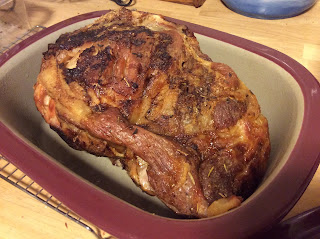Recipe: Herbed Pork Roast
Today on the Food Network, Chef Elizabeth Donald. Shush. Let me have my delusions of adequacy.
By request, the herbed pork roast recipe I experimented with on Sunday. I've tried to do pork roasts many times, and always ended up drying them out unless I used the crock pot and drowned them in liquid.
Now, that works perfectly fine if you're aiming for pulled pork. That's easy: slice an onion into rings and put them in the crock. Put the roast on top of the rings, and insert a half-dozen whole cloves into the flesh (more or less to taste). Toss more sliced onions on top if you want. Pour in two or three cups of water. Set the crock pot to cook on low 8-12 hours - the longer the better. When it's done, pull it out (as best you can; it will fall apart if you did it right) and discard the water, onions and cloves. Shred the meat like crazy and dump it back in the crock pot with another onion, diced. Pour in a full bottle of your favorite barbecue sauce (I strongly recommend Corky's of Memphis) and let it cook on low another half hour to one hour. Voila.
Here's how I finally managed an herbed roast without turning it into a bouncy ball:
Set the oven temperature at 300 degrees. Trim fat off the roast if you wish, though I prefer to keep a healthy layer of fat to season the meat as it cooks and render crackling skin.
Season the roast all over with your preferred rub. My standard go-to is 1 1/2 tsp. kosher salt flakes, 1 tsp. onion powder, 1/2 tsp. garlic powder, a dash of white pepper, and paprika, rosemary, tarragon and coriander to taste. But I like it salty. For this round, I added a dash of a seasoning blend from a little tourist-trap restaurant in Nowhere, Tennessee where I had the best pork chops of my life. My supply is getting low; I really need to make sure to stop by there the next time I swing through middle Tennessee.
You can use whatever seasoning rub you like - jerk seasoning for spicy, or add brown sugar for a sweeter taste. A Montreal rub would include paprika, black pepper, kosher salt, garlic and onion powder, coriander, dill and crushed red pepper flakes. Emeril's Essence Creole seasoning goes like this: 2 1/2 tbsp. paprika, 2 tbsp. salt, 2 tbsp. garlic powder, and one tbsp. each pepper, onion powder, oregano, thyme and cayenne pepper. (I omit the last from my Emeril seasoning because I'm a spice wuss.) This makes about 2/3 cup of the mix, enough for several recipes - it's great on beef.
Be sure to measure your seasoning out into a small bowl and mix it up, then begin the rub on all sides of the roast. Discard any leftover seasoning if your hands have touched both it and the meat.
By request, the herbed pork roast recipe I experimented with on Sunday. I've tried to do pork roasts many times, and always ended up drying them out unless I used the crock pot and drowned them in liquid.
Now, that works perfectly fine if you're aiming for pulled pork. That's easy: slice an onion into rings and put them in the crock. Put the roast on top of the rings, and insert a half-dozen whole cloves into the flesh (more or less to taste). Toss more sliced onions on top if you want. Pour in two or three cups of water. Set the crock pot to cook on low 8-12 hours - the longer the better. When it's done, pull it out (as best you can; it will fall apart if you did it right) and discard the water, onions and cloves. Shred the meat like crazy and dump it back in the crock pot with another onion, diced. Pour in a full bottle of your favorite barbecue sauce (I strongly recommend Corky's of Memphis) and let it cook on low another half hour to one hour. Voila.
Here's how I finally managed an herbed roast without turning it into a bouncy ball:
Set the oven temperature at 300 degrees. Trim fat off the roast if you wish, though I prefer to keep a healthy layer of fat to season the meat as it cooks and render crackling skin.
Season the roast all over with your preferred rub. My standard go-to is 1 1/2 tsp. kosher salt flakes, 1 tsp. onion powder, 1/2 tsp. garlic powder, a dash of white pepper, and paprika, rosemary, tarragon and coriander to taste. But I like it salty. For this round, I added a dash of a seasoning blend from a little tourist-trap restaurant in Nowhere, Tennessee where I had the best pork chops of my life. My supply is getting low; I really need to make sure to stop by there the next time I swing through middle Tennessee.
You can use whatever seasoning rub you like - jerk seasoning for spicy, or add brown sugar for a sweeter taste. A Montreal rub would include paprika, black pepper, kosher salt, garlic and onion powder, coriander, dill and crushed red pepper flakes. Emeril's Essence Creole seasoning goes like this: 2 1/2 tbsp. paprika, 2 tbsp. salt, 2 tbsp. garlic powder, and one tbsp. each pepper, onion powder, oregano, thyme and cayenne pepper. (I omit the last from my Emeril seasoning because I'm a spice wuss.) This makes about 2/3 cup of the mix, enough for several recipes - it's great on beef.
Be sure to measure your seasoning out into a small bowl and mix it up, then begin the rub on all sides of the roast. Discard any leftover seasoning if your hands have touched both it and the meat.

Comments
Post a Comment